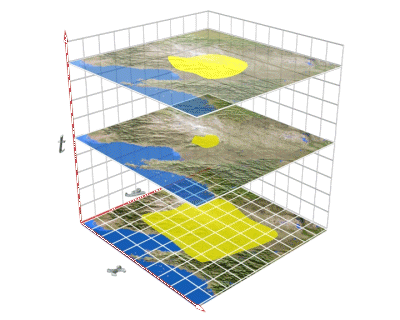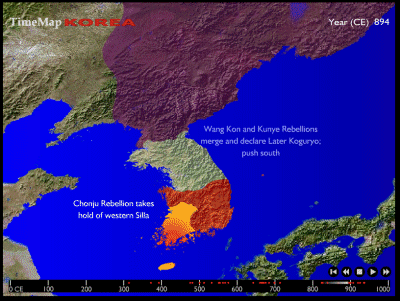
Figure 1: The space-time cube, showing evolution of a region through time
The simultaneous representation of the spatial and temporal components of archaeological and historical information has always posed a problem, because of limitations of the paper medium. The commonest approach – exemplified by popular atlases such as The Atlas of World Archaeology (Bahn 2000) is the representation of time slices (generally determined by cultural periodisation) through separate maps or distinctive symbologies on a single map. Where greater detail is known, or a process can be inferred between two known endpoints (such as the expansion of an empire or troop movements in a battle), trends through time are often illustrated through the use of arrows or successive fronts. Space and time are often represented together as a space-time 'cube' (Figure 1):

Figure 1: The space-time cube, showing evolution of a region through time
Perspective views of the space-time cube, such as Figure 1, are pretty much limited to displaying maps at well-separated points in time (a horizontal plane) or sites with a known time range (a vertical line). Combining time with all three spatial dimensions in a perspective view is pretty much impossible.
Although computer screens are no more dimensional than paper, they offer us several methods for overcoming the shortcomings of two-dimensional representation, resulting in part from their ability to calculate perspective but mainly from their ability to generate new versions rapidly on demand.
In order to represent continuous processes, such as spread of cultural traits or changing environments, one ideally needs to be able to set up a true volumetric view of the space-time cube. A volumetric view would allow us to understand the internal structure through the use of transparency, density and fog effects, rotation of viewpoint and/or stereo viewing. Such technology is currently beyond the financial and technical reach of most archaeologists. However, some simpler techniques can go a long way (see also Johnson 1999, 2.6)
Interactive maps allow one to slice the space-time cube horizontally (as shown in the animation in Figure 1), viewing a map of the area of interest at any given time and changing the time – along with other aspects such as zoom and symbolisatin at will. The map is regenerated immediately, allowing the observer rapidly to observe changes (most commonly by dragging a slider bar or clicking a forward/backwards button). Interactive maps allow the viewer to ask questions, revisit views of the map, turn layers on or off, zoom in or out, drill down for greater detail or experiment with symbolisation. As such they are suitable for enquiry and in a museum or educational context will probably be used in conjunction with pre-determined views, contextualising instructions or goal-setting questions. They may also be used to present large amounts of data for free exploration and research. We used this approach in the Sydney TimeMap kiosk discussed in section 6.1.
Map animation[1] (Campbell and Egbert 1990; diBiase 1994; see for example Figure 1 and several examples in Johnson and North 1997) builds on interactive mapping by linking a large number of time-slice maps into an animation, with or without transition effects between frames, using 'desktop time' to represent historical time. This approach typically generates very large non-interactive animation files (movies) such as the Mongol Empire animation illustrated in Figure 2. Map animations provide a more passive experience suited to highly curated visitor experiences or as resources within a structured curriculum, as well as providing a means of making simple points in an engaging, easily assimilated form. Our animation of the Mongol Empire shown in Figure 2 illustrates several things which might not be obvious in a series of static maps:
 Animation AVI 4Mbytes (sampled 1 frame/sec)
Animation AVI 4Mbytes (sampled 1 frame/sec) 
Temporal interpolation uses assumptions about the trajectory of change between recorded data points to generate best-guess intermediate maps or animation frames (Johnson 1999, 2.4). One common method is to place recorded versions of geographic objects along a timeline in an animation package such as Flash, and allow the package's shape-tweening algorithm to generate representations for the intermediate frames. This tweening capability is built into Flash player, resulting in much smaller movies - our Flash animation of the Shilla Dynasty, Korea (Figure 3), which is of far higher quality than the Mongol animation shown in Figure 2, uses only 1.3 MBytes for a 10-minute animation (approximately two orders of magnitude more compact). More sophisticated animation would determine the interpolation by modelling or simulating the processes behind the changes (e.g. Spikins 1997; Kohler and Carr 1997), thus conforming more accurately with reality (assuming the model used has some predictive power).
Interactive map animations which allow the user to interact with an animation, turn layers on or off and link from objects on the map to additional information, can be constructed with animation products such as Flash. An excellent example of this approach is the FlashGIS toolkit (Jessee 2001) - see for example Salem witch trial accusations and Civil War engagements. One of the particularly nice features of these interactive animated maps is the way the time bar indicates distribution of events and varies the animation rate according to event density (although it can be argued that this gives a distorted view of history, and appropriate cues should certainly be provided to make the changes in rate explicit). More limited interaction is available in the Shilla Dynasty animation (Figure 3) generated with TimeMap TMView and Macromedia Flash.

Figure 3: Map animation of the Shilla Dynasty, Korea. Created by Damian Evans using TimeMap TMView and Macromedia Flash
Click for animation [link via Internet Archive]
The logical conclusion of building interactivity into animation products is to build animation into interactive GIS. Monmonier (1996, 180) uses the term graphic script to describe a script which acts as a proxy for the user, generating a sequence of views in real time. Mainstream GIS products provide script languages which can be used in this way, and are moving towards the integration of animation with GIS functionality. Many can now generate simple animations with limited interactivity e.g. of GPS tracking data or 2.5-D flyovers. It is only a matter of time before the generation of animations based on simulation models or repeated analyses through time become core functionality.
[1] I use the term 'map animation':
Last updated: Wed Sep 11 2002
© Author(s). Content published prior to 2013 is not covered by CC-BY licence and requests for reproduction should usually go to the copyright holder (in most cases, the author(s)). For citation / fair-dealing purposes, please attribute the author(s), the title of the work, the Internet Archaeology journal and the relevant URL/DOI.